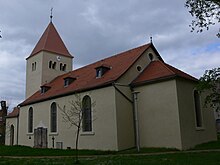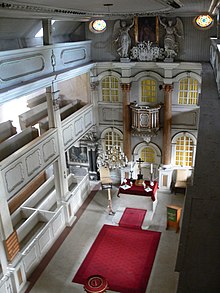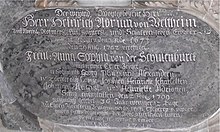St. Jakobus (Rottmersleben)




The Sankt-Jakobus-Kirche is the village church of Rottmersleben , Saxony-Anhalt . The tower has been preserved from the original Romanesque building. The nave and furnishings are baroque .
Origin of name
The church is dedicated to Saint James the Elder and is probably on an old branch of the pilgrimage route to Santiago de Compostela .
history
The oldest part of the church, the tower, is dated to around 980 AD, the nave to around 1709. Small loopholes on the ground floor of the tower testify to warlike times. The Jakobuskirche was the patronage church of the von Veltheim family until 1945 .
St. Jakobus was last extensively renovated in 2005. The quarry stone walls were plastered smooth. The second bell in the tower, which had been melted down during the last war, could also be replaced as part of the renovation. It was inaugurated on August 28, 2005 with a pageant.
Church registers from 1632 onwards are preserved and owned by the community. They can be viewed as a microfilm in the Magdeburg archives of the church province of Saxony (by appointment).
Location and building
The remains of a Carolingian rampart form a hill in Rottmersleben on which St. Jakobus and to the west of it the parsonage are located. The church is east and was previously surrounded by a cemetery. The rectangular sacristy is attached to the hall-style nave at the site of the former choir . The transverse rectangular tower with a tent roof has double arched windows in the east and west, which are divided by old sandstone columns with cube capitals. The tower received its attached vestibules on the north and south sides when the church was renovated in 1913. The tower and nave are connected by a round arch opening in the eastern tower wall, which extends from the ground floor to the height of the second nave gallery and the entire width of the tower wall occupies. Inside the tower, a wooden staircase leads to the bell chamber.
Church furnishings
The interior of the church shows a uniform baroque decor from the beginning of the 18th century. The dominant feature is the beautifully structured eastern display wall, which supports a pulpit between two mighty wooden pillars. Above that, above the cantilevered entablature, two genii hold an oil painting of Ecce homo , at their feet is the Veltheim / Schulenburg alliance coat of arms. Two-story wooden galleries run along the other three sides of the nave. The pulpit and the baptismal font in the center of the nave date from around 1700. The bench stalls and the richly decorated song board in the organ gallery are of a similar age - the lower tendril of the song board is said to come from the Wroclaw Cathedral . The historic organ was created around 1880 by master organ builder August Troch from Neuhaldensleben .
On the left of the east wall is a magnificent epitaph for Heinrich Adrian von Veltheim , which was erected on December 1, 1710 by his widow Anna Sophia "von der Schulenburck" . The precious work of slate and alabaster was done by Michael Helwig , Helmstedt. The portraits of the couple and their six children are painted in oil on copper. As in the display wall, plastic coats of arms of those of Veltheim and those of Schulenburg are attached in the upper area of the epitaph .
The patronage box is remarkably simple and relatively far from the altar under the organ gallery. In the southeast corner of the nave is an old church father's chair in the form of a small box with a vaulted tent roof.
crypt
Under the nave there is a vault with several closed and one open burial chamber. During the last world war, the crypt was accessible from the outside and served as an air raid shelter. Today it is available to pilgrims as a meditation room.
Outdoor area
On the south side of the church three grave monuments are integrated into the wall: M. Willrich, † 1736, Ilse Schultze, † 1661 and Henning Schultze, † 1655.
To the northeast of the church are two tombstone pedestals and two sandstone sarcophagi with rococo ornaments.
literature
- Documentation sheet in the Sankt-Jakobus-Kirche in Rottmersleben
- M.-L. Harksen The art monuments of the Haldensleben district , VEB EA Seemann Verlage, Leipzig 1961
Web links
Individual evidence
Coordinates: 52 ° 12 ′ 45 ″ N , 11 ° 24 ′ 5.8 ″ E